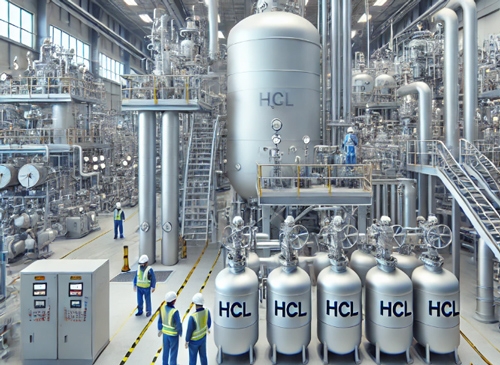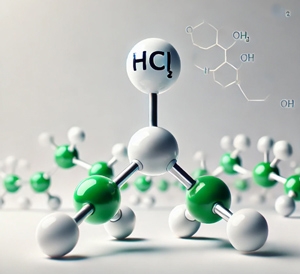Hydrogen Chloride is formed when Chlorine (Cl2) reacts with Hydrogen (H2) gas. It is highly soluble in water, and in humid environments, it rapidly dissolves to form hydrochloric acid (HCl). Hydrogen Chloride (HCl) gas is a colorless, pungent-smelling gas that is a major industrial chemical. It is commonly used in the production of hydrochloric acid and is present in various processes such as metal cleaning, food processing, and chemical manufacturing. HCl gas is highly corrosive and toxic, so detecting its presence in the air is crucial for both safety and regulatory compliance. In this blog post, we will explore various methods for detecting HCl gas, from chemical sensors to advanced detection technologies.
1. Why Detect HCl Gas?
- Health Hazards: Exposure to HCl can cause respiratory issues, skin irritation, and severe damage to the eyes.
- Industrial Safety: Preventing leaks and ensuring safe handling in industrial processes.
- Environmental Impact: Avoiding release into the atmosphere, which could lead to acid rain and harm local ecosystems.
2. Detection Methods for HCl Gas
There are several approaches to detecting HCl gas, each with its advantages and limitations. Below, we will go through some of the most widely used techniques:
2.1 Chemical Sensors
Chemical sensors are commonly used for detecting gases like Hydrogen Chloride. These sensors detect HCl gas by responding to its presence in the air and producing a change in an electrical signal, which is then processed into a readable output.
- Metal Oxide Semiconductors(MOS): These sensors use a metal oxide surface to interact with HCl gas. The gas molecules react with the sensor's surface, causing a change in the electrical resistance, which is proportional to the gas concentration. MOS sensors are often used in industrial applications because they are affordable and provide real-time detection.
- Electrochemical Sensors: These sensors pass the HCl gas through an electrolyte, which reacts with electrodes to produce an electrical current. The strength of the current is proportional to the concentration of HCl in the air. Electrochemical sensors are widely used in safety monitors because they offer high selectivity, accuracy, and a quick response time. Most GasDog gas detectors use the principle of electrochemical sensors for gas detection.
- Colorimetric Sensors: These sensors use a chemical reagent that reacts with HCl, causing a color change. The intensity of the color change is directly related to the concentration of the gas. Colorimetric sensors are easy to use and often employed for short-term, on-the-spot testing.
2.2 Gas Detectors
Gas detectors are portable or fixed devices used to monitor the concentration of gases, including HCl, in an environment. These devices come equipped with specialized sensors to detect different gases, and in some cases, multiple gas sensors can be integrated into a single unit for the simultaneous detection of various substances.
Portable Gas Detectors
These are handheld devices that workers can carry to monitor the air quality in real-time. Portable gas detectors are typically used for personal protection in industrial settings. They are lightweight, easy to use, and often feature an alarm to alert users when HCl concentration exceeds safe limits.
Fixed Gas Detectors
Installed at fixed locations in an industrial environment, these detectors continuously monitor air quality. They are often linked to a central control system that can trigger alarms or shutdown procedures if dangerous gas levels are detected. Fixed gas detectors are common in areas with high concentrations of HCl or where large-scale HCl production occurs.
2.3 Infrared (IR) Spectroscopy
Infrared spectroscopy is a non-dispersive detection technique that involves measuring the absorption of infrared light by HCl molecules. Different gases absorb infrared light at specific wavelengths, allowing for highly accurate and selective detection of HCl.
2.4 Laser-Induced Breakdown Spectroscopy (LIBS)
Laser-Induced Breakdown Spectroscopy(LIBS)is an advanced optical method that uses a focused laser pulse to generate plasma from a sample. The light emitted from the plasma is analyzed to detect the presence and concentration of elements or compounds, including HCl.
2.5 Gravimetric and Absorption Methods
Gravimetric methods involve passing air through a reagent that reacts with the HCl to form a product that can be weighed, allowing for the determination of HCl concentration. This method is generally not suitable for continuous or real-time monitoring but can be useful for laboratory analyses or when a high level of accuracy is required.
Absorption methods involve absorbing HCl gas into a solution or solid that reacts with the gas, causing a measurable change in the system. These methods are typically slower than other detection technologies but can be useful for low-concentration detection.

3. How to Choose a Detection Method?
When selecting a detection method for HCl gas, several factors should be considered:
- Sensitivity: The ability of the detection method to accurately detect low concentrations of HCl. For industrial environments, sensitivity requirements are often in the parts per million(ppm)range.
- Selectivity: A detector's ability to differentiate between HCl and other gases in the air. It's crucial to choose a sensor that targets HCl specifically to avoid false positives.
- Response Time: The time it takes for the sensor to detect HCl and provide a response. This is critical in ensuring timely alerts and safety measures.
- Durability and Maintenance: Industrial environments can be harsh, so the detector must be robust enough to withstand exposure to moisture, dust, and corrosive gases. Also, the ease and frequency of maintenance should be considered.
- Cost: Depending on your application, budget constraints may influence whether to choose a high-end system like an NDIR sensor or a more affordable electrochemical or colorimetric sensor.
Choosing the Right Detection Method
| Application | Recommended Method |
| Personal safety in the field | Portable gas detectors (e.g. GD200-HCL) |
| Industrial monitoring | Fixed gas detectors (e.g. GD300-HCL, GD700-HCL) |
| Spot-checks and troubleshooting | Colorimetric tubes |
| High-accuracy laboratory analysis | Infrared spectroscopy |
4. Safety Considerations and Guidelines for HCl Detection
Given the hazards associated with HCl exposure, it's crucial to establish proper safety measures when working with or around HCl gas:
- Wear Protective Equipment: Always use suitable personal protective equipment(PPE), including gloves, goggles, and respirators, when working with or detecting HCl gas.
- Monitor Continuously: In high-risk areas, install portable or fixed gas detectors for continuous monitoring of HCl levels.
- Set Alarm Thresholds: Ensure that gas detectors are set with alarms to notify workers when HCl concentrations exceed safe limits(typically around 5 ppm for continuous exposure).
- Regular Calibration: To maintain accuracy, it's vital to calibrate your gas detection equipment regularly and ensure sensors are functioning properly.
Detecting HCl gas in industrial environments is essential for ensuring safety and preventing exposure to this harmful substance. A variety of detection methods, including chemical sensors, infrared spectroscopy, and advanced techniques like LIBS, are available, each with unique strengths and applications. By carefully selecting the appropriate detection technology based on sensitivity, selectivity, and cost, industries can better protect their workers and comply with safety regulations.
Regular monitoring, calibration, and maintenance are key to ensuring that gas detection systems function reliably, providing an early warning system to prevent dangerous exposure to HCl gas.

